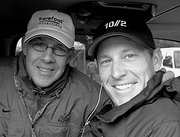To Your Health
June, 2007 (Vol. 01, Issue 06) |
|
|
For example, in the Tour de France, I would treat Lance Armstrong and his team twice a day - once before they went out to race and once when they came back from the race. Same thing with performers: You do it once before they go out on stage and once after. That way, you're preparing them to put in a top effort, but you're also protecting their body by doing some post-performance care to support their recovery. They are able to maintain the capacity to be a top performer and always be ready to jump into action at a moment's notice.
How would that translate for a weekend athlete or someone who is just very athletic as an amateur? What would you suggest for them? What would be a regimen that could keep them at the top of their game?
First off, their objective is to get well and stay well. If there are underlying health issues that need to be resolved to put them in a position to be involved in performances, that's the first thing that has to happen. Once they're there, the other side of it is to be a regular wellness patient, which is probably the more important side of it, because it takes a lot less time and effort to get rid of the problem while it's small than when it's gotten very large.
I'm a big fan of the practice of proactive wellness care. At a minimum, they should see the chiropractor once a month to address all the neuromusculoskeletal issues they may not know are in their body, but certainly could make them prone to a future injury.
If a top athlete/performer is injured, what does it take to get them back up to performance level?
 It takes a comprehensive program in neuromusculoskeletal care, proper use of modalities, use of nutritional supplements, and rehabilitation. The first thing is to aggressively control pain and inflammation and accelerate tissue repair. This can and should be done using manual chiropractic adjusting strategies; nutrition to make sure the body chemistry is on board, to control pain and inflammation, and accelerate tissue repair; and the appropriate modalities to speed those aspects of physiology that are consistent with accelerating tissue repair.
It takes a comprehensive program in neuromusculoskeletal care, proper use of modalities, use of nutritional supplements, and rehabilitation. The first thing is to aggressively control pain and inflammation and accelerate tissue repair. This can and should be done using manual chiropractic adjusting strategies; nutrition to make sure the body chemistry is on board, to control pain and inflammation, and accelerate tissue repair; and the appropriate modalities to speed those aspects of physiology that are consistent with accelerating tissue repair.
There are office and home rehabilitation protocols that need to be an essential part of any program so the body can reacquire the strength, flexibility, endurance and agility to be able to perform in a three-dimensional environment. It needs to be a comprehensive program and it needs to be extremely aggressive because the longer you wait, the less chance the person has of getting back to their optimal performance. Time is an issue, so the sooner you can get on the problem, the faster they can heal.
Compare passive care and active chiropractic care. How does active chiropractic care impact how quickly patients can recover?
Passive care is mostly about pain, and just because you're pain-free doesn't mean you're well. If you heal with a random scar and create an injury forcing the body to change how you move, it shifts where the stress goes in the body, which will eventually express itself as a second injury down the line. It's only a matter of time and I see that happen all the time.

